Black kitchen cabinets have become a consistent presence in modern interiors, valued for their visual clarity, material versatility, and resistance to short-lived trends.
This article explores why black remains a relevant and enduring choice across kitchen styles, layouts, and functional requirements. It analyzes black cabinetry from aesthetic, material, and practical standpoints, and explains why it continues to outperform fleeting trends in both private residences and commercial environments.
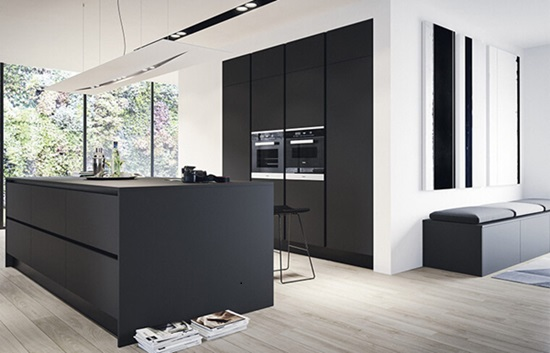
In kitchen environments, black kitchen cabinets introduces spatial control. It outlines surfaces, contains visual complexity, and defines zones without requiring physical partitions. Unlike brighter colors that tend to diffuse boundaries, black draws edges around volumes and gives kitchens a sense of coherence.
This visual clarity is not limited to contemporary settings. Even in eclectic or transitional interiors, black functions as a stabilizing base, framing natural textures like wood or stone. It absorbs excess and makes adjacent surfaces—whether they’re rough or polished—appear more intentional.
From a lighting perspective, black interacts with its surroundings in subtle ways. In direct sunlight, matte black absorbs harsh reflections and evens out glare, while in dim light, it creates tonal depth and textural contrast. These qualities make it suitable for kitchens with varied lighting conditions or open floor plans.
The association of black with formality and permanence contributes to its psychological effect. Where white or bright tones may energize, black produces calm. Its density carries visual weight that balances busy surfaces, open shelves, or expressive wall treatments.
Because of these qualities, black cabinetry is not a background element—it’s a compositional tool. Designers use it not to decorate but to regulate space. And in that way, it becomes timeless not because it disappears, but because it never relies on visual novelty to stay relevant.
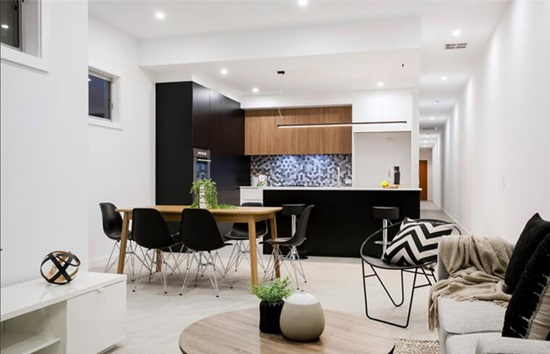
Black cabinetry supports minimalism not through visual absence, but through controlled expression. A matte black cabinet face, with no visible hardware or ornamentation, requires precise design execution. The lack of visual embellishment demands attention to proportion, edge alignment, and material quality.
In a space that often serves multiple functions—preparation, gathering, storage—black cabinets reduce visual clutter. Open kitchens benefit from this simplification. When cabinetry blends into the perimeter, the central functions of the room can be emphasized without the need for distracting focal points.
The material response of black also supports simplicity. In flat finishes, it diffuses light gently and resists the spotlighting effect often associated with glossy surfaces. This makes it a useful choice for kitchens where indirect lighting and layered illumination are used to build atmosphere.
Functionally, simplicity aids maintenance. Matte black finishes—especially fingerprint-resistant coatings—reduce the appearance of daily handling, moisture marks, or splashes. This allows for a more relaxed kitchen experience without constant visual correction or surface wiping.
In architectural terms, black cabinetry functions like a structural mass. It allows counters, flooring, and ceilings to engage in dialogue without having to compete with cabinet doors for attention. The end result is a cleaner, more resolved environment that emphasizes quality over decoration.
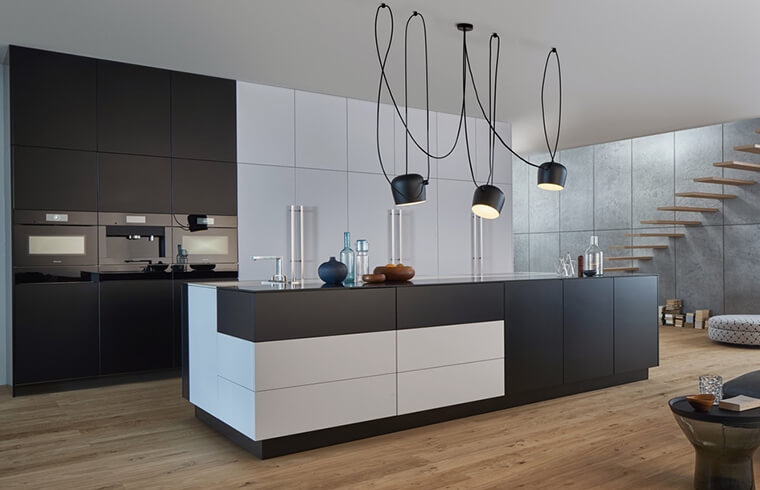
Contrast is one of the foundational strategies in interior design, and black cabinetry provides one of the strongest tools for achieving it. Against pale countertops or walls, black offers distinction. Against raw wood, it sharpens the warmth. With metals, it creates temperature contrast—cool on warm, matte on reflective.
This capacity to define and frame makes black an effective companion to expressive materials. A heavily veined marble slab becomes more prominent when paired with black base cabinets. A copper tap stands out more vividly when set against a dark background. In both cases, black serves not as decoration but as a mechanism to heighten other materials.
High-performance kitchen layouts also benefit from this strategy. By creating zones of color, contrast enhances legibility. A cooking area may feature black cabinetry while storage zones remain white or wood, increasing usability without resorting to labels or signage.
Importantly, black’s contribution to contrast is not limited to color. It also mediates between textures. A soft leather stool, a brushed metal handle, a honed concrete floor—all of these acquire definition when framed by black. As such, black can be used to connect materials that might otherwise appear unrelated.
This design strategy—contrast through containment—makes black cabinetry an essential element in kitchens that prioritize intentionality, hierarchy, and visual logic.
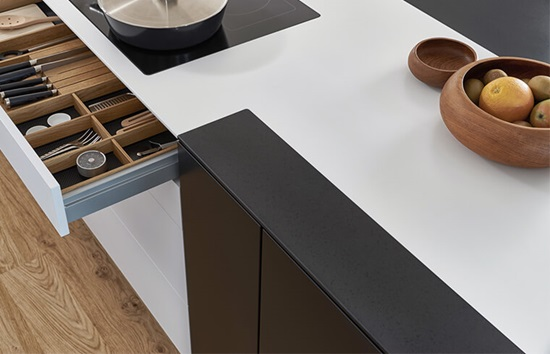
The practical performance of kitchen cabinetry is critical. It is one of the most heavily used components in the home, subject to frequent contact, fluctuating temperatures, and exposure to food residue, moisture, and cleaning agents.
Black finishes, particularly when selected in ultra-matte or structured coatings, respond well to these conditions. They reduce the visibility of dust, minor surface abrasions, and occasional watermarks. Unlike high-gloss finishes that reflect smudges and fingerprints, matte black maintains visual consistency across use cycles.
Colorfastness is another consideration. Exposure to indirect sunlight over time can cause yellowing or fading in light-colored surfaces. Black, when made with stable pigments and UV-resistant coatings, retains chromatic stability far longer. This ensures that a kitchen planned today will retain its integrity years later, even in high-use zones.
Cabinet hardware also benefits from black finishes. Integrated pulls or recessed channels in black reduce contrast with door faces, minimizing wear visibility and preserving aesthetic clarity. Hinges and runners hidden within carcasses operate independently of finish, ensuring function and design remain decoupled.
The choice of black cabinetry is not merely stylistic—it’s tactical. It serves households that cook frequently, entertain often, or operate in shared environments. In these contexts, durability is not an accessory; it’s foundational.
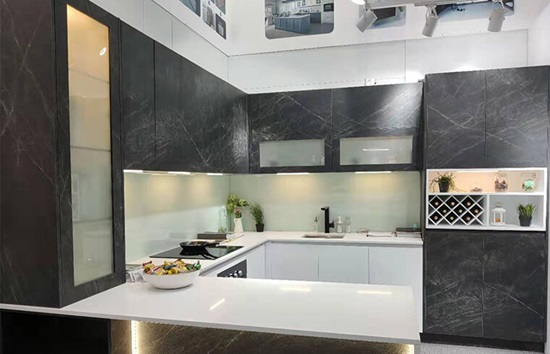
Black cabinetry is not tied to any singular architectural era or aesthetic trend. Its neutrality and visual authority allow it to span a wide range of applications, from rustic to industrial, minimalist to transitional.
In traditional kitchens, black shaker cabinets balance heritage details with restraint. Their strong vertical and horizontal lines offer formal order without excessive embellishment. In such settings, black pairs well with aged brass, walnut counters, and beadboard paneling.
In modern or urban loft environments, flat-panel black cabinets align with steel beams, exposed ducts, and concrete surfaces. Their precision complements the industrial palette without appearing cold. Texture adjustments—such as brushed laminates or soft-matte coatings—introduce warmth without changing the color scheme.
Scandinavian interiors benefit from black's anchoring capacity. Used sparingly, such as on lower cabinets or tall storage walls, black balances pale floors, white walls, and minimal ornamentation. It allows light to circulate while giving the kitchen a focal framework.
Eclectic homes—where owners combine antiques with custom-built elements—use black cabinetry as a unifying field. It accommodates variation, absorbs eccentricity, and ties together disparate volumes through its consistent density.
Because of this flexibility, black cabinetry is one of the few design elements that can be applied broadly without compromising specificity. It absorbs context and reflects use.
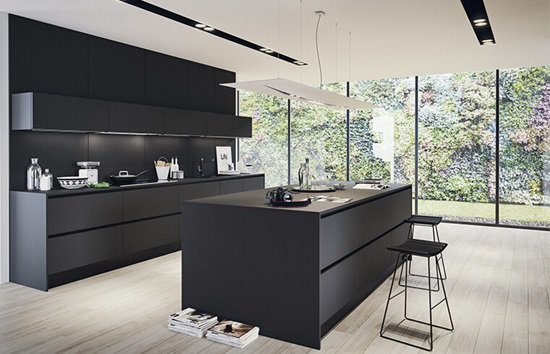
Timelessness in kitchen design is often described as neutrality, but in practice, it’s more than that. It’s about avoiding design fatigue. Black avoids this not by being invisible, but by being structurally foundational.
Unlike trend-driven colors—teal, mustard, blush—that reference specific cultural moments, black exists outside of seasonality. Its presence in interiors spans centuries and continents, from Victorian butler’s pantries to contemporary studio apartments. This makes it one of the few finishes that feels equally appropriate in new construction and renovation projects.
The psychological consistency of black contributes to this effect. It is perceived as orderly, composed, and restrained. These qualities do not age quickly. A white kitchen might feel dated depending on the tone or trim. A pastel kitchen might need refreshing after a few years. But a black kitchen remains legible.
Timelessness also relates to replaceability. Black cabinets accept updates without losing coherence. New appliances, countertop swaps, upgraded hardware—these changes don’t require a new cabinet system. Black accommodates evolution.
In this sense, black cabinetry is not resistant to change—it is resilient within it.
The performance of black in a kitchen depends heavily on finish selection. Glossy black, for instance, reflects light and creates high visual energy. It is suited to minimal spaces where cabinetry functions as an accent wall. However, it can show fingerprints, requiring frequent maintenance.
Matte black reduces reflectivity and surface distractions. It absorbs ambient light and allows adjacent surfaces to play a more prominent visual role. For open kitchens integrated with dining or living areas, matte finishes offer a subdued and cohesive backdrop.
Structured laminates with woodgrain embossing or textile patterns provide tactile variation while maintaining a monochrome palette. These materials introduce richness without relying on color. They also improve grip and resist scratches better than flat finishes.
Finish choice must also consider maintenance cycles. Soft-touch coatings, often used in premium cabinetry, resist stains and can be cleaned with mild agents. Thermofoil wraps offer budget-friendly durability but require careful handling to avoid peeling.
Ultimately, finish transforms black from a flat tone into a responsive design tool. It determines whether the cabinetry feels bold or discreet, architectural or artisanal, industrial or residential. Aesthetic consistency arises not from color alone but from surface behavior.
Lighting strategy is essential in kitchens where black is a dominant visual element. Because black absorbs light, it reduces ambient brightness, which can affect task visibility if not addressed with deliberate lighting design.
Under-cabinet LED strips improve clarity on work surfaces while introducing linear structure to wall cabinetry. Spotlights or directional ceiling fixtures ensure vertical surfaces retain depth and avoid flattening into shadows. These targeted light sources prevent black cabinetry from becoming visually heavy.
Ambient lighting—via pendants or ceiling washes—softens edges and moderates contrast. Warm white bulbs (2700K–3000K) prevent the space from feeling clinical, while cooler tones (3500K–4000K) emphasize precision and cleanliness.
Reflections are also a key consideration. Metallic handles, glossy backsplashes, and composite countertops redistribute light, creating movement and maintaining spatial energy. Black cabinetry becomes a background element within this system, supporting rather than suppressing dynamic range.
When coordinated correctly, lighting elevates black cabinetry from passive structure to active spatial feature.
For those seeking kitchen cabinetry that combines long-term performance with aesthetic consistency, black remains a proven choice. It offers clarity in open layouts, resilience under frequent use, and visual neutrality across evolving design trends.
BFP Cabinetry offers a curated range of black kitchen cabinet solutions in matte, gloss, and textured finishes, accompanied by flexible internal storage and layout options. Our product systems are designed to support functionality while maintaining clean, high-impact visual presentation.
To explore materials, configuration options, or consult on a new project, contact us at sales7@bfpglobal.com.
We employ cookies to analyze website traffic and enhance your browsing experience. Data securely aggregated, privacy protected. See Privacy Policy for details.